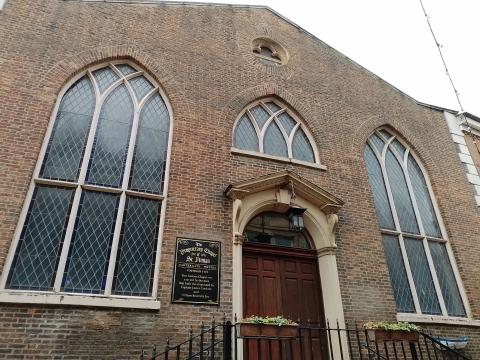The Proprietary Chapel of St Ninian

Whitby's Proprietary Chapel of St Ninian is an historical curiosity (which is probably what most Britons think about most churches). 'Proprietary' refers to its private ownership but its owners’ intention to offer it for public worship (as opposed to a private chapel which was only ever intended for one family or the staff of one estate). Built in 1778, it closed as a place of worship in 2019, but not before leaving the Church of England as a protest at its ordination of women in 1994. Although I could not gain entry on account of its ceasing to trade, I did meditate upon its externals and its interesting association with Captain Cook of Australasian fame. The frontal windows are neogothic in shape which is unusual for the eighteenth-century, while its main entrance boasts a rounded arch. Above it sits a third window, which matches its neighbours in width but not in height, lending it a rather odd feel. It is one of those buildings to which I would be hard pressed to date if a blue plaque had not been conveniently positioned. A snobbish, but amusing writer in an 1874 edition of The Architect: A Weekly Illustrated Journal of Art, Civil Engineering and Building described it as a ‘debased edifice of Queen Anne, or…Dolly Varden architecture’. Dolly Varden was a Dickens character from Barnaby Rudge who lent her name to a range of twee Victorian ladies’ fashion styles. Alfred Lee's music hall song of that name from 1872 went:
Have you seen my little girl? She doesn’t wear a bonnet.
She's got a monstrous flip-flop hat with cherry ribbons on it.
She dresses in bed furniture just like a flower garden
A blowin' and a growin' and they call it Dolly Varden.
There is something a little chintzy about the Whitby’s St Ninian’s; although pretty, its windows’ design are a little gaudy and tasteless. It was paid for by ordinary (though not poor) townsmen of Whitby, whose architectural tastes were questionable, though they doubtless considered themselves fashionable. Celebrated fashions, whether of the garment, the arts, opinions or theologies, often appear dated and naff within a few years of their vogue. In Colossians 1:23 Paul writes to the church which was being led astray by worldly philosophy:
If ye continue, grounded and established in the faith, and be not moved away from the hope of the Gospel, whereof ye have heard, and which hath been preached to every creature… (Geneva)
The heresies they were imbibing were culturally fashionable and well regarded, but to us, and certainly to heaven, they were peculiar, false, foolish and crass. Beware of fashion; it soon goes out.

- Log in to post comments


 Sunday Worship 10.45am & 6.00pm
Sunday Worship 10.45am & 6.00pm